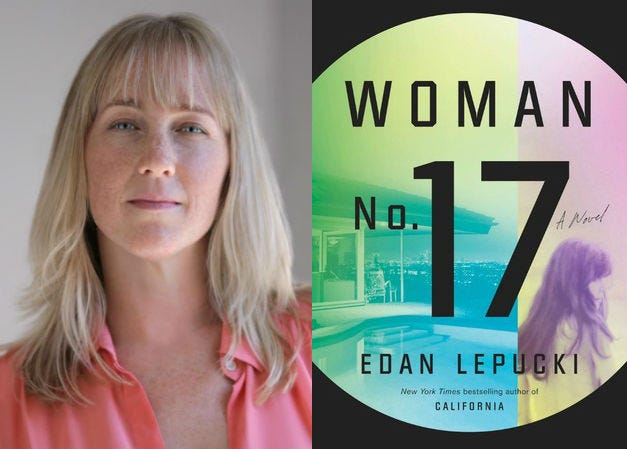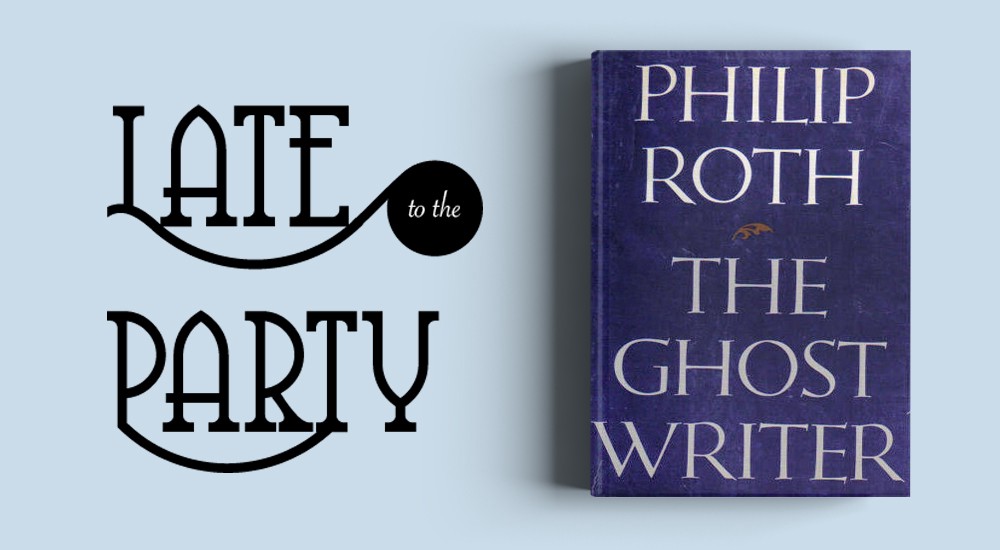Interviews
Edan Lepucki Loves Her ‘Unlikable’ Characters
Edan Lepucki considers the appeal of characters who do reckless things and asks herself what it means to be a ‘good mom’

Edan Lepucki’s second novel, Woman No. 17, is a sexy noir concerning an unlikely friendship between two self-destructive women — Lady, a forty-year-old writer and Esther, a recent college grad/aspiring artist. When Lady breaks from her husband, she haphazardly hires Esther — known as “S” — to help out with her spry toddler. S moves into Lady’s guesthouse in the Hollywood Hills with family baggage and a hidden agenda, and quickly becomes Lady’s sole confidante. Though Lady confesses her deepest, darkest secrets to S, the lies S tells intensify as she begins a dangerous romance with Lady’s eighteen-year-old son, Seth, who’s never spoken a word.
Whether it’s writing a bestseller, remaining composed for a live TV interview with Stephen Colbert (where, in 2014, she became a cause célèbre — part of Colbert’s fight against Amazon), helping her students craft and publish their work, keeping up with her two small children or making readers love unsympathetic characters, Lepucki does it all with ease and enthusiasm. I love knowing her and reading her, and I was elated to have this opportunity to call her at home in the Bay Area to talk to her about bad moms, art snobs, and Woman No. 17.

Arnold: This story concerns a writer whose editor suggests she write about her son. You have a son. Did your editor or agent convince you to write about being a mom or what was the germ of the story?
Lepucki: Nobody asked me to write about my son, though the seed of the story definitely came from my own life as a mother. When my son was about fifteen months old, he wasn’t yet speaking. That’s normal for that age, but he was my first child, and my nephew spoke very early, and so I became paranoid that my own son was delayed, and not only that, but that he would remain silent. It’s sort of like when women are forty-weeks pregnant and become convinced they are never going to give birth, although, obviously, they will! I started to imagine what it would be like if your child didn’t speak, and more importantly, what would your relationship with your child be like and how would it be changed? At the same time, I had read this book by Andrew Solomon called Far from The Tree about parents of children who are different from them. There are chapters about autistic children, another about schizophrenic children, and so on; each one concerns a different community and identity, and all the parents in the book are heroic in some way. They manage to find a connection with their child and advocate for them and understand that the story of their child belongs to their child and isn’t about them. Of course, I was curious about a parent not like that. The story (of Woman No. 17) began with this idea of Lady, the mother of a kid who does not speak. I asked myself: What if she wasn’t an accepting mother? What if she couldn’t wrap her head around how to raise a child with a disability?
Arnold: An author has to love something about each of her characters. Lady and S, your two narrators, often act like awful people. What do you love most about each of them?
Lepucki: I really like both of them! [Laughs] I knew from the onset that they were going to be quote-unquote unlikable. As soon as Lady was on the page she had this kind of judgmental quality to her. She doesn’t understand herself very well. I knew people were going to have an issue with her — that, or enjoy her bad behavior. The same thing with S. She does some reprehensible things and is very reckless. But I was interested in their voices, how they speak, the way that they see the world. I think both of them are very funny. I know I wrote these characters, but they are not me: I was simply their mouthpiece. They both have troubled relationships with their own moms. They both want to connect with people. S really wants her art to reach people and she wants to understand who her mom is and why she drinks herself silly. Like S, I was a child who shuttled between divorced parents, and so I feel for her. For Lady, I identified with her struggles with motherhood. I mean, we don’t have the same situation and I wouldn’t make the same choices that she made, but I understood her sense of isolation and wanting to do the best for her child and not really knowing what that is. She doesn’t really have a model to follow. Thankfully, I do. My mom was and is a great mom, and I feel like whenever I need help she’s there for me. Lady doesn’t have that privilege, and my heart goes out to her. So they were really fun to write and it was fun to watch them spiral out of control, but I also just love them and felt their vulnerabilities.
Arnold: Is Lady a bad mom?
Lepucki: I don’t know. I think that’s for the reader to decide. One of my questions for the book is: What does it mean to be a bad mom or a good mom? For me, being a good mom means being present with my children, being patient with them, putting their needs before mine — but within reason. Handling discipline well. There are so many different elements. It’s just a constant dance. And, at times, I find it difficult to be present, and deal with their manic, child craziness…especially after not having slept! So it’s a big question for me: Am I a good mom? Aside from obviously bad mothers who harm their children, I don’t know what makes a mother good. I think it’s a complicated question. As for Lady, she doesn’t always do what’s best for herself or her children, but I also think she loves her children. It’s an imperfect love, but it is there.
“Am I a good mom? Aside from obviously bad mothers who harm their children, I don’t know what makes a mother good. I think it’s a complicated question.”
Arnold: You mentioned Seth being mute. He is otherwise healthy and normal. Why did this degree of his disability interest you?
Lepucki: After I was deep into the book I regretted my choice to some degree because it’s hard to write a scene of dialogue with someone who does not speak! At a certain point, you’re like, wait, how many times can someone raise his eyebrows? [Laughs] I knew he didn’t speak and early on I talked to a friend of mine who is a therapist. I asked her what would be some reasons why a child wouldn’t speak. She works with a lot of children and asked if he has autism, because autistic children often have delayed speech or limited speech. Or they don’t speak due to an anxiety issue. But I wanted Seth to be able to read and negotiate minor emotional social cues, and I thought if he were impaired in other ways, it would be difficult for him to be an agent in some of the drama of the narrative. I needed him to be savvy in these social ways. I also met with my friend who is a speech therapist and we talked about what his malady could be. One of the things I landed on was Selective Mutism, which isn’t an accurate diagnosis for Seth because he doesn’t speak ever and people who have Selective Mutism often speak to one or two people. I thought about how frustrating it would be, to be a parent of a child who didn’t have a diagnosis that described your child. Parents of children on the autism spectrum sometimes experience this because not everything in the diagnosis fits their child. In that case, the question is, well, do they really have an impairment? There is a frustration and pain in not having an answer to the question: Why is my child like this? I think the fact that I didn’t have a direct diagnosis for Seth works in Lady’s favor and how she struggles with Seth. I also know it’s an exceptional case. He doesn’t speak, but he can also communicate easily — he doesn’t have social anxiety. I compare it to when you read a mystery novel where there’s a unique, sensationalist murder — Is it possible? Yes. Is it probable? No. It’s fiction. Seth literally cannot speak, but he does communicate very well. The women in the novel? They talk a whole lot, but their communication skills could use some work!
Arnold: It’s implied in the novel that Seth’s early childhood trauma of losing his father, Marco, may have led him to close down. How did Marco’s absence form Seth?
Lepucki: I think it’s Lady’s perception that, because she cannot find a reason for Seth’s silence, then it must be because of trauma. One of the reasons people stop speaking is trauma. Normally, that trauma is major, such as witnessing a murder or being sexually abused (that’s what happened to Maya Angelou, as she describes it in I Know Why the Caged Bird Sings). In Seth’s case, the trauma of losing Marco was more enacted on Lady. She’s still processing it and hasn’t faced the pain of it. She’s still not over her baby daddy! But I do think that the abandonment also hurt Seth, because it meant that Lady isolated the two of them further. Had there been another person in that family dynamic the way that Karl is there now, Seth would have probably gotten better services, and the family would have integrated into a community of non-speaking people. Marco’s abandonment has more of an effect on Lady, and how Lady deals with Seth, than on Seth himself.
Arnold: I thought you did a great job capturing that self-righteousness artists sometimes have about themselves or their work. Both Esther and Kit take pictures. I loved your Elle piece about being a photographer’s muse. Can you speak here to what sparked your desire to write about photographers?
Lepucki: First of all, I did not title the Elle piece. I would never call myself a muse! When S showed up on the page I hadn’t planned for her to be a big part of the book. I didn’t think she was going to narrate half of it, but as soon as she was in scene I was really fascinated by her. As soon as she admired the photograph of the Pizza Hut in Lady’s house, I saw that she was interested in art. To my surprise, I had this artist figure — though maybe it’s not such a surprise, since I have always loved to hang out with visual artists. Like I said in the Elle piece, all my roommates in college were art majors — that is, if they weren’t English majors. And to this day I love to talk to the artists I know about process and how they come up with images.
In some way, the visual art in Woman No. 17, namely when S becomes her mother for this performance piece, is a surrogate for fiction writing. S’s project is much more extreme than writing, as you know, but when we are writing fiction we do become other people. I am not S and I am not Lady, and I would not do most of the things they do, but I did, in a sense, get to do them when I wrote. I think I poured some of that experience into S’s way of being in the world. Then there’s Kit Daniels, who is the famous photographer. I loved writing her — she’s such a bitch! I would spend, like, an hour describing her outfits for every scene.
After having written the book, I find myself reading profiles of Sophie Calle, a famous French artist whose work I love so much. And I just read an article about this woman who is a muse and has asked all these famous photographers to take her portrait. She has a collection of like two hundred portraits. That’s an act of art in and of itself. While I was reading it, I thought, Someone has to write a novel about this woman! It’s not going to be me.
Arnold: Where did the ideas for both Kit’s and Esther’s individual photo projects come from?
Lepucki: You know how it is: you start writing and suddenly things emerge. Or that’s how it feels to me, as if these ideas simply appear, without reason, and I take them without questioning where they came from. However, recently, my friend Christine Frerichs, who is a painter, read a description of the book and she wondered if she’d had an influence on the character of S. Christine reminded me that when she was in college she did a photography project about her own mother, who passed away. For the project, Christine dressed as her mother and photographed herself in these outfits, one for each day that her mother had been in a coma. I remembered the project after Christine described it to me, though I had forgotten about it until that moment. But it certainly connected to S’s project; Christine’s photos must have stuck in my subconscious in some way.
As for Kit’s photographs, I honestly have no memory where the Women Series came from, but I’ve always loved portraits taken by photographers like Diane Arbus and Sally Mann, those very provocative black and white photos of people that are kind of staged and kind of candid. They give you a sense of somebody’s identity, but there’s also a mystery about who the person in the photo really is. That stuff has always been appealing to me so it’s not surprising that I wrote about it.
Arnold: Esther’s secret project subverts the distinction between art and reality. In your mind, is there a fine line or is it clearer than Esther sees it? Is she the crazy drunk person she is portraying in this world or is she really faking it?
Lepucki: I think that’s the question of the novel! The thing about S is that she’s young. Some people at that age know very clearly who they are and what they want and how they want to be in the world, but she’s not one of those people. And because of that she has a nimble identity. That she can drink so easily and take on this role of her mother, or who she assumes her mother is, scares her. It begs the question: Is this a role, or is it her true self? You can’t fake that far! At the same time, she understands that her performance doesn’t totally match up to her mother. Her mother is far more honest than S is. Deceit is at the center of S’s project. Also, her mother is much more open with her body and very affectionate and doesn’t really care what people think of her. S wants those qualities in herself so she’s using this project as means to be those things. I wanted the reader’s idea of S to collapse so that you don’t really know what’s truly her, and what’s her performance.
Arnold: S does a lot of drinking. Did you do any research?
Lepucki: You know what’s funny — during revision I drank so much! In every scene where they were drinking sparkling wine I’d be like, “I’m getting sparkling wine tonight because it’s so good and I’ve described it in such loving detail!” [Laughs] But I didn’t do any of the private drinking of straight tequila or vodka. That sordid, secret drinking was not appealing to me. One reader review called Lady an alcoholic as well as S, and I was like, is Lady an alcoholic? And then I was like, oh my God am I an alcoholic and don’t know it?
Arnold: I’m going to ask you a question you once asked me: are you an artist? Are writers also artists?
Lepucki: When did I ask you that? Was that my pickup line for you? [Laughs] What did you tell me?
Arnold: I said no, but then I thought about it a lot and decided maybe I was. I mean, I’m definitely a weirdo and I’m artsy. When I was younger I used to make art. My mom still wears my jewelry sometimes. But she paints and I grew up believing an artist was someone who paints or draws, which I can’t do.
Lepucki: My answer is both yes and no. On the one hand, no. There’s something a little bit more mundane about writing, because all of us write every day, be it in emails or on Facebook or a note to our spouse. There’s a sense that writing is much more enmeshed in our everyday lives, which makes it less like art. But I also think that writing is an art form, and I always say that writing is the best art form because it shows us consciousness. No other art form can do that. That’s what makes it so beautiful and important. Some days I think that I am an artist because I have to step outside of myself and the situation I’m in to see it closely, and that is the role of the artist: to observe culture and comment on it through music or painting or photography or a short story. Sometimes I write a sentence that feels like art. A lot of times I feel like I’m not living up to the art that I would like to make. But that’s my life goal — to become an artist.
Arnold: What are you working on next?
Lepucki: I have seventy pages of a new book, which I will not say anything about. But of course it takes place in LA and I’m sure all the characters are unlikable!
Renaissance Rebels: 7 Women Saints Who Resisted








